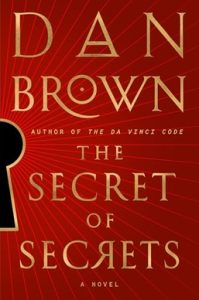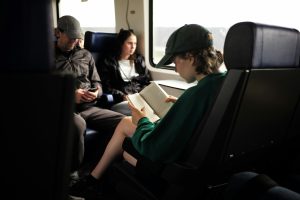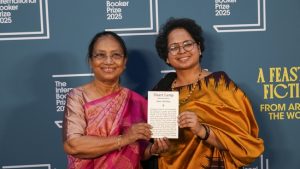Article First Published in the Morning BY Savithri Rodrigo.
This article originally appeared in The Morning and was written by Savithri Rodrigo.
Savithri Rodrigo is the host, director, and co-producer of the weekly digital show Kaleidoscope, which can be watched on YouTube, Facebook, Instagram, and LinkedIn. She brings more than thirty years of experience across print, electronic, and social media platforms.
- Gratiaen Prize Winner 2025 Savin Edirisinghe on why he wrote ‘Kata Katha’
This year’s Gratiaen Prize winner is dyslexic, and he grew up in a Sinhala-speaking household. He started learning English at the age of nine, straddling two languages and literature – reading George Orwell (Eric Arthur Blair) and Oscar Fingal O’Fflahertie Wills Wilde with the same enthusiasm as Lama Hewage Don Martin Wickramasinghe and Mahagama Sekara and writing adventure stories in English despite confusing ‘b’ and ‘d’ among other dyslexia-prone issues.
But, Savin Edirisinghe’s ‘Kata Katha: Gossips, Rumours and Idle Talk’ did much more than win the 32nd Gratiaen Prize; it bridged the space between English and Sinhala languages, it walked the tightrope that defines new writers in multiple languages, and it became a story to uphold in English literature expectations. Edirisinghe, who works at Charana Television and is a marketer at Loops International, is one of the youngest to win the Gratiaen and discussed the whys and wherefores of his win on ‘Kaleidoscope’.
Following are excerpts from the interview:
How do you feel after winning the Gratiaen Prize this year?
Actually, pretty overwhelmed – but, in a good way.
This collection of short stories began with the 2024 Future Writers’ Programme. Tell me more?
Yes, so that’s where I actually got the courage to submit one of my short stories. I’ve been writing for as long as I can remember, but, I wanted to submit it to that particular programme. The main reason that I wanted to get into that programme was because of Ashok Ferrey and the judges – I admire their writing, so I wanted them to read mine. That’s the main reason. I never thought that I would win.
So, what was the biggest challenge in putting this collection together?
I would say the writing part because I had many techniques for a start. Even now, I don’t consider myself to be a writer, because to be a writer, you should be doing it all the time. But, that was difficult for me because there were too many stories in my head and that’s why I think I leaned towards writing a short story collection rather than a novel. Writing down the actual ideas that were inside my head was the difficult part.
Why did you hone in on gossip, of all things?
I’m only 25 and I haven’t seen many of the things that much more experienced and seasoned writers have, so it was like a game of hide and seek. I listened to other people’s experiences and stories. I did a lot of eavesdropping. I talked to people that I found interesting, those about whom I thought ‘okay, this guy has a story’. That’s why it’s called ‘Gossip’ – it’s the glue that sticks all the stories together.
You grew up in a Sinhala-speaking household. How do you manage the two languages?
There’s this quote by the first Roman emperor Charlemagne, who said: ‘To have a second language is to have a second soul’. But, in a poem that I wrote called ‘Bilingual Sankara’, I write: ‘I possess two souls, one I was born with, the other I was forced with. The latter is part of me, the prior is me…’
So, in that context, I know two languages and these two languages may cancel each other out. In turn, I may have no soul at all. But then, choosing one or the other was very difficult for me; having the idea and then choosing which language to write it in.
For poetry, I mostly use Sinhala, but, for prose, I use English, so I’m bipolar in that manner. I still don’t know what language to use, but I suppose that it is a good balance for the moment.
How did your dyslexia shape your writing skills?
Even now you should see my first drafts; a mass of red lines on my computer – grammar and spelling mistakes. The speed of my thinking is much faster than the speed of my writing. That makes my handwriting especially bad. Sometimes my idea runs away from me, so I try to slow myself down – especially my mind – and then write in a way that’s not accurate, but at least it gets the idea down on paper. Then I start editing.
In writing your short stories, is there a common thread that runs through?
I would say that the people – the characters in the stories. They’re very special characters because most are inspired by real-life people. But, even if they read it themselves, they would find that the characters have been drastically changed by the author. They are extreme versions of what these real-life people could be. So, if you have a benevolent character in real life, in my stories that character goes to the extreme and vice versa – if it’s bad, then it’s very bad.
Is there anything you would have written differently? Anything you would change?
Not at the moment, because I haven’t had any audience feedback or reviews. The book has just been published. But, once the feedback or reviews come in, changes are left to be seen. For now, I’m very happy with it. I stopped at 13 short stories intentionally. I could have written two more and gone up to 15, which is the more accepted number. But, I stopped at 13 because I thought ‘okay, this is done’. Even now, when I revisit the process, I can’t rate them. And I don’t want to, because they’re done.
Do you have a favourite character in the book?
I wrote a love poem and a love letter to my girlfriend which are in the book. This is the only part of myself that’s actually in it. Character-wise and real-person-wise, my girlfriend would be my favourite.
You’re only 25 and you’ve managed to bridge a gap between English and Sinhala literature. Did you set out with that goal or were you just doing what you wanted to do?
I did set out with that in mind. My father was a huge inspiration – he was a Sinhala writer, a journalist, and he did his Master of Business Administration and Doctor of Philosophy (PhD) in Sinhala. I’ve always found Sinhala literature to be more complex and beautiful than English literature – and Tamil literature as well, which is even richer.
Translation is a huge part of this. The Gratiaen Trust has done a great job – their translation prize is very important to the entire industry. When you look at the whole of literature though, the most important books in Sinhala and Tamil haven’t been translated into English.
That’s when I thought, ‘Let’s not translate – let’s write the ideas of Sinhala or Sri Lankan culture in English’. This has been done by many authors – Shehan Karunatilaka, Ferrey, Yasmine Gooneratne, and others. Maybe I’m bringing a youth perspective to it – a 21st-Century outlook where English and Sinhala are inseparable. Everyone’s speaking English now, and Sinhala is even being written using English words.
What advice would you give to young writers?
Write until you feel right. That’s what I did. I wrote until I felt right – inside and outside.
It’s subjective, of course. I don’t feel right instantly. It takes time. But, some people might write something and instantly feel right about it. That happens too. So, I’d say, trust your gut. Write till you feel right.
What’s next for you?
Writing – now I have to write! – so I’ll be working on novels and short stories and I want to return to poetry too, because that’s where I started. I love poetry. Writing poetry is the most ‘Gen-Z’ thing to do, because it’s very instant; instant to write, instant to read, so I would go in that direction too. Maybe become a poet in the future.
(The writer is the host, director, and co-producer of the weekly digital programme ‘Kaleidoscope with Savithri Rodrigo’ which can be viewed on YouTube, Facebook, Instagram and LinkedIn. She has over three decades of experience in print, electronic, and social media)






